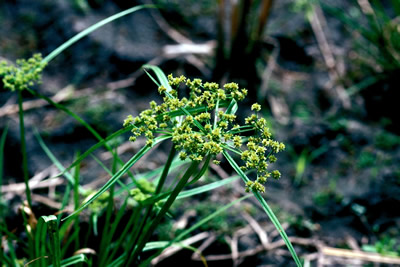Cyperus difformis

Latin name
Cyperus difformis L.
Family
Cyperaceae
Common name
Small flower umbrella plant
Synonyms
Cyperus lateriflorus Torr., C. difformis var. maximus C.B. Clarke, C. difformis var. breviglobossus Kük., C. difformis var. subdecompositus Kük.
Geographical distribution
Asia: China, Japan, and Korea.
South and Southeast Asia: Bangladesh, Cambodia, India, Indonesia, Lao PDR, Malaysia, Myanmar, Nepal, Pakistan, Philippines, Thailand, Sri Lanka, and Vietnam.
Rest of the world: Australia, Cameroon, Ecuador, Egypt, Fiji, Ghana, Iran, Liberia, Madagascar, Mexico, Nicaragua, Nigeria, Portugal, Swaziland, Tanzania, Turkey, United States, West Africa and Zimbabwe.
Morphology
The weed is annual, fibrous and reddish roots; up to 100 cm tall.
Stem: tufted, smooth and erect, triangular and 2−3 mm thick; slightly winged.
Leaf: three to 4 basal leaves; sheaths united at base, lower ones straw-colored to brown; blades flaccid and linear, 15−45 cm long.
Inflorescence: umbellate and subtended by two leaf-like bracts; rays 1−5 cm long, some with long peduncle, some without stalk; spikelets numerous, crowded in masses about 2−5 mm long, each spikelet composed of 10−30 flowers.
Fruit: brownish nut, elliptical to slightly obovate, about 0.6 mm long and lightly pitted.
Biology and ecology
The small flower umbrella plant grows well in flooded or moist fertile soils and common in lowland rice. Also found on poorer sandy or clay soils in fallow lands but cannot tolerate deep flooding. It has a short life span; propagates by seeds and produces seeds throughout the year.
Agricultural importance
It produces large quantities of seed and can complete life cycle in about 30 days. A dominant weed in direct-seeded rice when it occurs in high plant densities; forms dense mats of vegetation in the young crop and can cause rice yield losses of 12−50%.
It is an alternate host of Xanthomonas campestris.
Management
Cultural control: hand and mechanical weeding in row-planted rice plants can provide effective control.
Chemical control: Bentazon, butachlor, 2,4-D, MCPA, pretilachlor, propanil, and thiobencarb reported to be effective.
Selected references
- Holm LG, Plucknett DL, Pancho JV, Herberger JP. 1977. The world's worst weeds: distribution and biology. Honolulu Hawaii (USA): The University of Hawaii Press. 609 p.
- Kern JH. 1974. Cyperaceae. Flora Malesiana Ser. 1 7(3): 435-753.
- Moody K. 1981. Major weeds of rice in South and Southeast Asia. Manila (Philippines): International Rice Research Institute. 79 p.
- Moody K. 1989. Weeds reported in rice in South and Southeast Asia. Manila (Philippines): International Rice Research Institute. 442 p.
- Moody K, Munroe CE, Lubigan RT, Paller Jr. EC. 1984. Major weeds of the Philippines. Weed Science Society of the Philippines. College Laguna (Philippines): University of the Philippines at Los Baños 328 p.
- Pancho JV, Obien SR. 1995. Manual of ricefield weeds in the Philippines. Muñoz, Nueva Ecija (Philippines): Philippine Rice Research Institute. 543 p.







